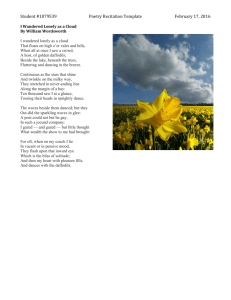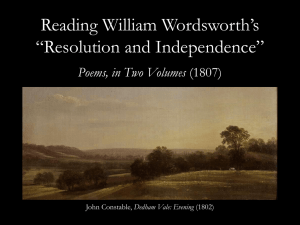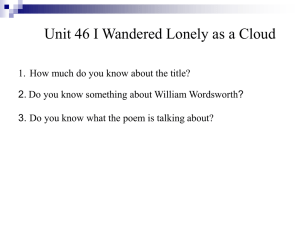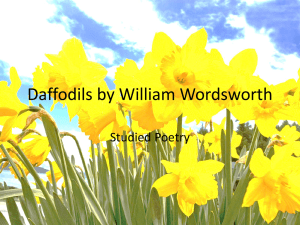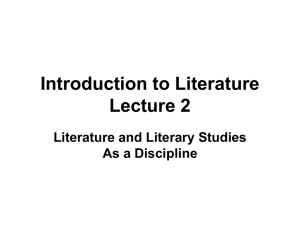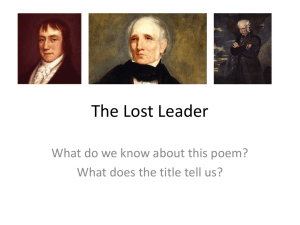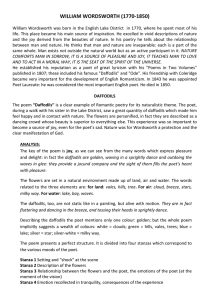I Wandered Lonely as a Cloud
advertisement
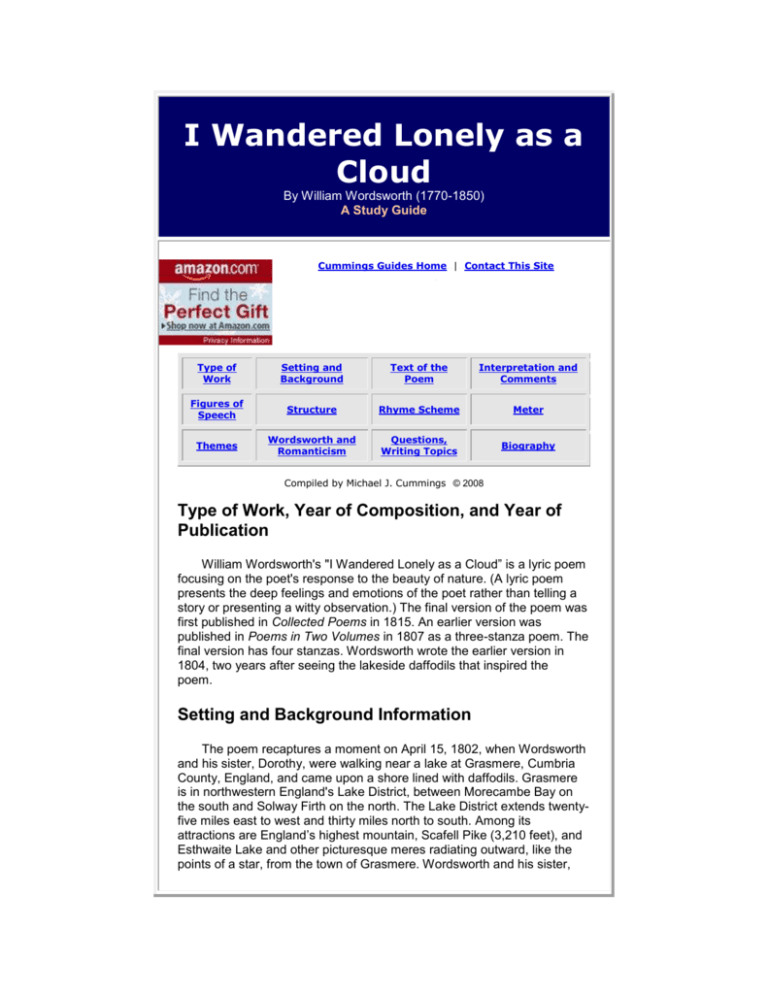
I Wandered Lonely as a Cloud By William Wordsworth (1770-1850) A Study Guide Cummings Guides Home..|..Contact This Site . . Type of Work Setting and Background Text of the Poem Interpretation and Comments Figures of Speech Structure Rhyme Scheme Meter Themes Wordsworth and Romanticism Questions, Writing Topics Biography Compiled by Michael J. Cummings...© 2008 . Type of Work, Year of Composition, and Year of Publication .......William Wordsworth's "I Wandered Lonely as a Cloud” is a lyric poem focusing on the poet's response to the beauty of nature. (A lyric poem presents the deep feelings and emotions of the poet rather than telling a story or presenting a witty observation.) The final version of the poem was first published in Collected Poems in 1815. An earlier version was published in Poems in Two Volumes in 1807 as a three-stanza poem. The final version has four stanzas. Wordsworth wrote the earlier version in 1804, two years after seeing the lakeside daffodils that inspired the poem. Setting and Background Information .......The poem recaptures a moment on April 15, 1802, when Wordsworth and his sister, Dorothy, were walking near a lake at Grasmere, Cumbria County, England, and came upon a shore lined with daffodils. Grasmere is in northwestern England's Lake District, between Morecambe Bay on the south and Solway Firth on the north. The Lake District extends twentyfive miles east to west and thirty miles north to south. Among its attractions are England’s highest mountain, Scafell Pike (3,210 feet), and Esthwaite Lake and other picturesque meres radiating outward, like the points of a star, from the town of Grasmere. Wordsworth and his sister, Dorothy, moved to a cottage at Grasmere in 1799. After Wordsworth married in 1802, his wife resided there also. The family continued to live there until 1813. The Lake District was the haunt of not only Wordsworth but also poets Robert Southey, Samuel Taylor Coleridge, and Thomas De Quincey. Dorothy, who kept a diary, described what she and her brother saw on that April day in 1802: When we were in the woods beyond Gowbarrow park we saw a few daffodils close to the water side, we fancied that the lake had floated the seeds ashore & that the little colony had so sprung up— But as we went along there were more & yet more & at last under the boughs of the trees, we saw that there was a long belt of them along the shore, about the breadth of a country turnpike road . . . [S]ome rested their heads on [mossy] stones as on a pillow for weariness & the rest tossed & reeled & danced & seemed as if they verily laughed with the wind that blew upon them over the Lake, they looked so gay ever glancing ever changing. This wind blew directly over the lake to them. There was here & there a little knot & a few stragglers a few yards higher up but they were so few as not to disturb the simplicity & unity & life of that one busy highway... —Rain came on, we were wet. . . I Wandered Lonely as a Cloud Final Version (1815) By William Wordsworth 1 I wandered lonely as a cloud That floats on high o'er vales and hills, When all at once I saw a crowd, A host, of golden daffodils; Beside the lake, beneath the trees, Fluttering and dancing in the breeze........6 Summary, Stanza 1 While wandering like a cloud, the speaker happens upon daffodils fluttering in a breeze on the shore of a lake, beneath trees. Daffodils are plants in the lily family with yellow flowers and a crown shaped like a trumpet. Click here to see images of daffodils. 2 Continuous as the stars that shine And twinkle on the milky way, They stretched in never-ending line Along the margin of a bay: Ten thousand saw I at a glance, Tossing their heads in sprightly dance........12 Summary, Stanza 2 The daffodils stretch all along the shore. Because there are so many of them, they remind the speaker of the Milky Way, the galaxy that scientists say contains about one trillion stars, including the sun. The speaker humanizes the daffodils when he says they are engaging in a dance. 3 The waves beside them danced; but they Out-did the sparkling waves in glee:— A poet could not but be gay In such a jocund company: I gazed—and gazed—but little thought What wealth the show to me had brought:.....18 Summary, Stanza 3 In their gleeful fluttering and dancing, the daffodils outdo the rippling waves of the lake. But the poet does not at this moment fully appreciate the happy sight before him. In the last line of the stanza, Wordsworth uses anastrophe, writing the show to me had brought instead of the show brought to me. Anastrophe is an inversion of the normal word order. 4 For oft when on my couch I lie In vacant or in pensive mood, They flash upon that inward eye Which is the bliss of solitude, And then my heart with pleasure fills, And dances with the daffodils.............24 Summary, Stanza 4 Not until the poet later muses about what he saw does he fully appreciate the cheerful sight of the dancing daffodils. Worsworth again uses anastrophe, writing when on my couch I lie and my heart with pleasure fills. . . Examples of Figures of Speech Stanza 1 Alliteration: lonely as a cloud (line 1). Simile: Comparison (using as) of the speaker's solitariness to that of a cloud (line 1). Personification: Comparison of the cloud to a lonely human. (line 1) Alliteration: high o'er vales and Hills (line 2). Alliteration: When all at once (line 3). (Note that the w and o have the same consonant sound.) Personification/Metaphor: Comparison of daffodils to a crowd of people (lines 3-4). Alliteration: golden Daffodils (line 4). Alliteration: Beside the Lake, beneath the trees, Personification/Metaphor: Comparison of daffodils to dancing humans (lines 4, 6). ....... Structure and Rhyme Scheme .......The poem contains four stanzas of six lines each. In each stanza, the first line rhymes with the third and the second with the fourth. The stanza then ends with a rhyming couplet. Wordsworth unifies the content of the poem by focusing the first three stanzas on the experience at the lake and the last stanza on the memory of that experience. ..... Meter .......The lines in the poem are in iambic tetrameter, as demonstrated in the third stanza: ..........1..............2..................3...................4 The WAVES.|.be SIDE.|.them DANCED;.|.but THEY ......1................2..................3................4 Out-DID.|.the SPARK.|.ling WAVES.|.in GLEE:— ....1.............2.............3.............4 A PO.|.et COULD.|.not BUT.|.be GAY ......1.............2...........3............4 In SUCH.|.a JOC.|.und COM.|.pa NY: .......1................2..................3.................4 I GAZED—.|.and GAZED—.|.but LIT.|.tle THOUGHT ...........1....................2............3...............4 What WEALTH.|.the SHOW.|.to ME.|.had BROUGHT: In the first stanza, line 6 appears to veer from the metrical format. However, Wordsworth likely intended fluttering to be read as two syllables (flut' 'RING) instead of three so that the line maintains iambic tetrameter. Themes 1. Nature' s beauty uplifts the human spirit. Lines 15, 23, and 24 specifically refer to this theme. 2. People sometimes fail to appreciate nature's wonders as they go about their daily routines. Lines 17 and 18 suggest this theme. 3. Nature thrives unattended. The daffodils proliferate in splendor along the shore of the lake without the need for human attention. . Wordsworth and Romanticism .......In English literature, Wordsworth and his friend, Samuel Taylor Coleridge, were pioneers in the development of the Romantic Movement, or romanticism, a movement that championed imagination and emotions as more powerful than reason and systematic thinking. “What I feel about a person or thing,” a romantic poet might have said, “is more important than what scientific investigation, observation, and experience would say about that person or thing.” Intuition–that voice within that makes judgments and decisions without the aid of reason—was a guiding force to the romantic poet. So was nature. Romanticism began in the mid1700's as a rebellion against the principles of classicism. Whereas classicism espoused the literary ideals of ancient Greece and Rome— objectivity, emotional restraint, and formal rules of composition that writers were expected to follow—romanticism promoted subjectivity, emotional effusiveness, and freedom of expression . “I want to write my way,” the romantic poet might have said, “not the way that writers in ancient times decreed that I should write.” Study Questions and Writing Topics 1. In the preface to the second edition of Lyrical Ballads (1800), written by Wordsworth and Samuel Taylor Coleridge, Wordsworth presents his ....definition of poetry: Poetry is the spontaneous overflow of powerful feelings: it takes its origin from emotion recollected in tranquillity: the emotion is contemplated till, by a species of reaction, the tranquillity gradually disappears, and an emotion, kindred to that which was before the subject of contemplation, is gradually produced, and does itself actually exist in the mind. ....Write an essay explaining whether "I Wandered Lonely as a Cloud" illustrates what Wordsworth was saying in his definition. 2. Wordsworth believed that nature and human intuition impart a kind of knowledge and wisdom not found in books and formal education. Do you ....agree? Explain your answer. 3. Identify an example of hyperbole in the poem. 4. If Wordsworth had written walked instead of wandered in the first line, would he have ruined the poem? Explain your answer. 5. Write a short poem focusing on a natural wonder—a flower, a mountain, a waterfall, a violent storm, an animal, or a solar or lunar eclipse—that ....impressed you. . ..
